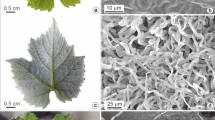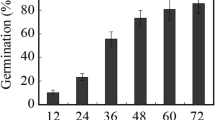Abstract
Elsinoë ampelina, the causal agent of grapevine anthracnose, infects all aboveground succulent parts of the plant, causing serious yield losses. There are no histopathological reports on this pathogen interaction with grapevine tissues. This study aimed at understanding the infection and colonisation processes of E. ampelina on Vitis labrusca cv. Niagara Rosada leaves by light, transmission and scanning microscopy. From one to five germ tubes per conidia were formed during conidia germination, predominantly one or two. Cuticle degradation was observed on plant surface underneath germ tubes and appressorium-like structures were rare. Monilioid and branched hyphae were observed 48 h post inoculation. Direct penetration occurred only on the adaxial leaf surface due to high trichome density on the abaxial leaf surface and conidia trapped on trichomes were frequently observed. The colonisation process was similar in the leaf blade, veins and petiole with the formation of inter- and intracellular hyphae. Phenolic compounds accumulated in infected areas; however, they did not prevent the colonisation progress. Tissues of foliar blade were totally changed by cell collapse and conidiogenous cells were observed on the surface of necrotic lesions. Ascus-like structures were observed within deeply unstructured tissues of leaf veins and necrotic areas of the petiole.




Similar content being viewed by others
References
Agrios, G. N. (2005). Plant pathology (5th ed.). Burlington: Elsevier Academic Press.
Amorim, L., Spósito, M. B., & Kuniyuki, H. (2016). Doenças da videira. In L. Amorim, J. A. M. Rezende, A. Bergamin Filho, & L. E. A. Camargo (Eds.), Manual de Fitopatologia: Doenças das Plantas Cultivadas (pp. 745–758). São Paulo: Editora Agronômica Ceres.
Barros, L. B., Biasi, L. A., Carisse, O., & De Mio, L. L. M. (2015). Incidence of grape anthracnose on different Vitis labrusca and hybrid cultivars and rootstocks combination under humid subtropical climate. Australasian Plant Pathology, 44, 397–403.
Brook, P. J. (1973). Epidemiology of grapevine anthracnose, caused by Elsinoe ampelina. New Zealand Journal of Agricultural Research, 16, 333–342.
Camargo, U. A., Tonietto, J., & Hoffmann, A. (2011). Progressos na viticultura brasileira. Revista Brasileira de Fruticultura, 33, 144–149.
Carisse, O., & Lefebvre, A. (2011). A model to estimate the amount of primary inoculum of Elsinoë ampelina. Plant Disease, 95, 1167–1171.
Carisse, O., & Morissette-Thomas, V. (2013). Epidemiology of grape anthracnose: Factors associated with defoliation of grape leaves infected by Elsinoë ampelina. Plant Disease, 97, 222–230.
EPPO (European and Mediterranean Plant Protection Organization) (2016). Elsinoë ampelina. https://gd.eppo.int/taxon/ELSIAM/distribution. Accessed 5 Jun 2018.
Fan, X. L., Barreto, R. W., Groenewald, J. Z., Bezerra, J. D. P., Pereira, O. L., Cheewangkoon, R., & Crous, P. W. (2017). Phylogeny and taxonomy of the scab and spot anthracnose fungus Elsinoë (Myriangiales, Dothideomycetes). Studies in Mycology, 87, 1–41.
Feder, N. E. D., & O'Brien, T. P. (1968). Plant microtechnique: Some principles and new methods. American Journal of Botany, 55, 123–142.
Feng, J., Wang, F., Hughes, G. R., Kaminskyj, S., & Wei, Y. (2011). An important role for secreted esterase in disease establishment of the wheat powdery mildew fungus Blumeria graminis f. sp. tritici. Canadian Journal of Microbiology, 57, 211–216.
Gabel, A. W., & Tiffany, L. H. (1987). Host-parasite relations and development of Elsinoë panici. Mycologia, 79, 737–744.
Gregory, M., & Baas, P. (1989). A survey of mucilage cells in vegetative organs of the dicotyledons. Israel Journal of Botany, 38, 125–174.
Horridge, G., & Tamm, S. (1969). Critical point drying for scanning electron microscopic study of ciliary motion. Science, 163, 817–818.
Hughes, J., & McCully, M. E. (1975). The use of an optical brightener in the study of plant structure. Stain Technology, 50, 319–329.
IBGE (Instituto Brasileiro de Geografia e Estatística) (2019). Levantamento sistemático da produção agrícola. https://sidra.ibge.gov.br/tabela/6588#resultado. Accessed 20 Feb 2019.
Karnovsky, J. M. (1965). A formaldehyde-glutaraldehyde fixative of high osmolality for use in electron microscopy. Journal of Cell Biology, 27, 137–138.
Kim, K. W., Hyun, J. W., & Park, E. W. (2004). Cytology of cork layer formation of citrus and limited growth of Elsinoe fawcettii in scab lesions. European Journal of Plant Pathology, 110, 129–138.
Kono, A., Sato, A., Ban, Y., & Mitani, N. (2013). Resistance of Vitis germplasm to Elsinoë ampelina (de Bary) Shear evaluated by lesion number and diameter. HortScience, 48, 1433–1439.
Kortekamp, A., & Zyprian, E. (1999). Leaf hairs as a basic protective barrier against downy mildew of grape. Journal of Phytopathology, 147, 453–459.
Kubicek, C. P., Starr, T. L., & Glass, N. L. (2014). Plant cell wall–degrading enzymes and their secretion in plant-pathogenic fungi. Annual Review of Phytopathology, 52, 427–451.
Li, Z., Dang, H., Yuan, X., He, J., Hu, Z., & Wang, X. (2018). Morphological characterization and optimization of conditions for conidial production of Elsinoë ampelina, the causal organism of grapevine anthracnose. Journal of Phytopathology, 166, 420–428.
Maia, J. D. G., Camargo, U. A., Tonietto, J., Zanus, M. C., Quecini, V., Ferreira, M. E., & Ritschel, P. (2015). Grapevine breeding programs in Brazil. In G. A. Reynolds (Ed.), Grapevine breeding programs for the wine industry (pp. 247–271). Cambridge: Elsevier.
Marques, J. P. R., Spósito, M. B., Mello, A. F. S., Amorim, L., Mondin, M., & Appezzato-da-Glória, B. (2012). Histopathology of black spot symptoms in sweet oranges. European Journal of Plant Pathology, 133, 439–448.
Marques, J. P. R., Amorim, L., Spósito, M. B., & Appezzato-da-Glória, B. (2013a). Histopathology of postbloom fruit drop caused by Colletotrichum acutatum in citrus flowers. European Journal of Plant Pathology, 135, 783–790.
Marques, J. P. R., Soares, M. K. M., & Appezzato-Da-Gloria, B. (2013b). New staining technique for fungal-infected plant tissues. Turkish Journal of Botany, 37, 784–787.
Mason, D. L., & Backus, M. P. (1969). Host-parasite relations in spot anthracnose of Desmodium. Mycologia, 61, 1124–1141.
Murria, S., Kaur, N., Arora, N., & Mahal, A. K. (2018). Field reaction and metabolic alterations in grape (Vitis vinifera L.) varieties infested with anthracnose. Scientia Horticulturae, 235, 286–293.
Pascholati, S. F., & Dalio, R. J. D. (2018). Fisiologia do parasitismo: como os patógenos atacam as plantas. In L. Amorim, J. A. M. Rezende, & A. Bergamin Filho (Eds.), Manual de Fitopatologia: Princípios e Conceitos (pp. 389–421). São Paulo: Editora Agronômica Ceres.
Pascholati, S. F., Deising, H., Leite, B., Anderson, D., & Nicholson, R. L. (1993). Cutinase and non-specific esterase activities in the conidial mucilage of Colletotrichum graminicola. Physiological Molecular Plant Pathology, 42, 37–51.
Paudyal, D. P., & Hyun, J. W. (2015). Physical changes in Satsuma mandarin leaf after infection of Elsinoë fawcettii causing citrus scab disease. The Plant Pathology Journal, 31, 421–427.
Paudyal, D. P., Hyun, J. W., & Hwang, R. Y. (2017). Infection and symptom development by citrus scab pathogen Elsinoë fawcettii on leaves of Satsuma mandarin. European Journal of Plant Pathology, 148, 807–816.
Reynolds, E. S. (1963). The use of lead citrate at high pH as an electron-opaque stain in electron microscopy. The Journal of Cell Biology, 17, 208–212.
Sakai, W. S. (1973). Simple method for differential staining of paraffin embedded plant material using toluidine blue O. Stain Technology, 48, 247–249.
Santos, R. F., Spósito, M. B., Ayres, M. R., & Sosnowski, M. R. (2018a). Phylogeny, morphology and pathogenicity of Elsinoë ampelina, the causal agent of grapevine anthracnose in Brazil and Australia. Journal of Phytopathology, 166, 187–198.
Santos, R. F., Ciampi-Guillardi, M., Amorim, L., Massola, N. S., & Spósito, M. B. (2018b). Aetiology of anthracnose on grapevine shoots in Brazil. Plant Pathology, 67, 692–706.
Santos, R. F., Spósito, M. B., Ayres, M. R., & Sosnowski, M. R. (2018c). In vitro production of conidia of Elsinoë ampelina, the causal fungus of grapevine anthracnose. European Journal of Plant Pathology, doi.org/10.1007/s10658-018-1502-z.
Shear, C. L. (1929). The life-history of Sphaceloma ampelinmn de Bary. Phytopathology, 19, 673–679.
Thind, T. S. (2015). Anthracnose. In W. Wilcox, W. Gubler, & J. Uyemoto (Eds.), Compendium of grape diseases, disorders, and pests (pp. 17–19). St Paul: APS Press.
Thind, T. S., Arora, J. K., Mohan, C., & Raj, P. (2004). Epidemiology of powdery mildew, downy mildew and anthracnose diseases of grapevine. In S. A. M. H. Naqvi (Ed.), Diseases of fruits and vegetables (pp. 621–638). Dordrecht: Springer.
Williamson, B., & McNicol, R. J. (1989). The histology of lesion development in raspberry canes infected by Elsinoe veneta. Annals of Applied Biology, 114, 35–44.
Acknowledgements
We would like to FAPESP for financial support (project n° 2013/24003-9), NAP-MEPA, ESALQ/USP for electron microscope facilities. This study was also financed in part by the Coordenação de Aperfeiçoamento de Pessoal de Nível Superior - Brasil (CAPES) - Finance Code 001.
Author information
Authors and Affiliations
Corresponding authors
Ethics declarations
This manuscript is original and complies to the ethical rules applicable for this journal.
Conflict of interest
The authors do not present any actual or potential conflict of interests.
Electronic supplementary material
ESM 1
(DOCX 929 kb)
Rights and permissions
About this article
Cite this article
Braga, Z.V., dos Santos, R.F., Amorim, L. et al. Histopathology of infection and colonisation of Elsinoë ampelina on grapevine leaves. Eur J Plant Pathol 154, 1009–1019 (2019). https://doi.org/10.1007/s10658-019-01721-2
Accepted:
Published:
Issue Date:
DOI: https://doi.org/10.1007/s10658-019-01721-2




